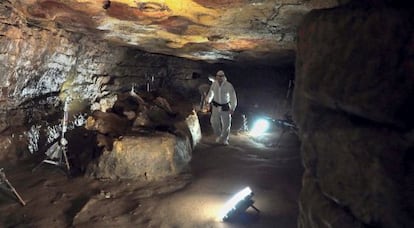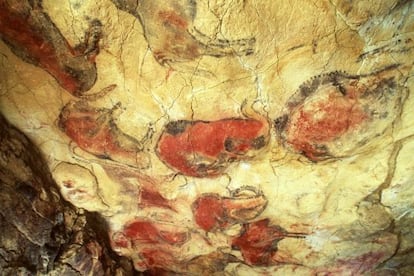Are visitors, or Mother Nature, damaging Altamira’s cave paintings?
Spain’s Culture Ministry has been handed conflicting reports on preserving the Unesco site


Since their discovery in the late 19th century, the world-famous Altamira caves in Cantabria, northern Spain, have been the subject of fierce debate. Initially, the main topic was the exact provenance of prehistoric paintings inside them – created anywhere up to 35,000 years ago. These days, however, it’s whether members of the public should be allowed to set foot in the site.
The caves were closed to visitors in 2002 as a result of the damage their presence was thought to be causing, and a replica was constructed in the nearby visitor center. But earlier this year, they were partially reopened, with groups of five people chosen via a lottery to enter the Unesco World Heritage Site.
But the disagreement goes on between those scientists who claim that the paintings will be damaged by the presence of visitors and, on the other hand, those who argue that the deterioration is a natural process, and would happen whether they were opened to the public or not.
The Culture Ministry has received two contradictory reports on the subject: the first, a 2012 document from the Spanish State Research Council (CSIC), concluded that opening the caves to visitors was a danger; the second, carried out by a team led by conservation expert Gael de Guichen, and completed in September, states that the visits do not affect the paintings. Neither of the reports has been published in their entirety, although ministry sources revealed this week that they would be made public in the coming months.

CSIC teams monitored the cave during different periods between 1996 and 2012. Until 2002, the studies were undertaken while visits were allowed, and analyzed the effect of 900 groups of five people each. During later years, the research was carried out under agreements with the Culture Ministry. The results were published in Science magazine in 2011, and left no doubt as to the damaging effect of visitors.
The coordinators of the research, Sergio Sánchez-Moral and Cesáreo Saiz-Jiménez, explain that they cannot make the results of their work public until the Culture Ministry does so, but they confirm that the Science article, and a book due to be published in the UK, entitled The Conservation of Subterranean Cultural Heritage, detail their main findings.
Their conclusions are clear: the cave should not be opened because of the high risk that microorganisms that are activated and feed off light pose to the paintings. This is what nearly destroyed the cave art at Lascaux, France, in the 1960s. “Some of the red ceiling paintings are partially covered by white colonies of bacteria, and their progress is clear to see,” they explain. “At the same time, fungi are invading the air in the cave, with the highest concentrations in the area with the paintings. That’s to say, any kind of risk threshold has already been exceeded.”
Sánchez-Moral and Saiz-Jiménez explain that the decision was made to close the cave in September 2002 after a report of theirs “in which closure was recommended as well as the total elimination of light, because the polychrome paintings on the ceiling were colonized by phototrophic organisms” – those that acquire energy from light. “They had appeared as a result of the intense illumination that they received due to the daily visits, and in particular the photographs that were taken during the preparation of the replica caves,” they continue. “When we removed our equipment in September 2012, those organisms had diminished but they were still there, and their reactivation is practically guaranteed if the ceiling is lit up. They are microorganisms that can last a long time without light and rapidly reactivate after receiving small doses of illumination.”
Shortly after this information was made available, in December 2011 the director of the Altamira caves, José Antonio Lasheras, told the EFE news agency: “The complete closure of a cultural heritage site is something of a failure.” Barely eight months later, in August 2012, the Culture Ministry began a new research program under the direction of De Guichen. Alfonso Muñoz, the director of the Spanish Cultural Heritage Institute, explains that this second project was put in motion “because the work being done by the CSIC was focused mostly on microbiology and it was necessary to carry out global research.”
The report produced by the team directed by Gael de Guichen arrives at contrary conclusions, as reflected in a summary sent out by the Culture Ministry and statements made by the investigator himself. According to the discoveries of this team, made up of around 50 people, the biggest dangers for the cave are natural ones, and are not related to the presence of humans. An experimental program of visits was carried out during the period of the study and the caves were also filmed for a documentary. The second report insists that “the processes of pigment loss are related to a number of factors: the water flow and condensation, the composition of the water, the relief of each surface and its relation to the network of cracks.”
The summary released by the Culture Ministry states: “No evident cause-effect relationship was found between the presence of researchers and visitors to the polychrome chamber and the loss of pigment.”
“The lighting errors caused the closure of the cave in 2002,” explains José Antonio Lasheras, who has been in charge of the Altamira caves since 1991. The current experimental visits, he explained, consist of five people and one guide, and make use of headlamps. During the filming of the documentary, he explains, the light levels were closely monitored. “The mission when it comes to the management of heritage is to ensure conservation and adequate use, and what may have been considered adequate before might not be so now, and vice versa. I proposed the closure of the caves in 2002 and I am responsible for the current system of public visits. Since the Altamira Museum was created, the closures have been temporary and the opening to the public is dependent on the control of the state of conservation,” explains Lasheras. In recent years, Lasheras has made numerous statements to the press saying that he is in favor of the caves receiving visitors.
The complete closure of a cultural heritage site is something of a failure” Director of the Altamira caves, José Antonio Lasheras
Lawrence Guy Straus, a professor of anthropology at the University of New Mexico, did not participate in either of the two reports, but states that “there is always controversy at Altamira over the visits and closures.”
He adds: “I don’t believe that opening the cave to the public is convenient for conservation. It’s a unique legacy that’s more than 14,000 years old. The more people talk about opening it and the more it is opened, the greater public pressure will be to open it more and more. We need to learn lessons from the past. Caves with paleolithic art are very fragile and need very conservative management. That is why there is an excellent replica in Altamira.”
Oscar Moro is an archeology professor from Cantabria, who now teaches at the University of Newfoundland. He has no doubt that there has been political pressure to reopen the cave. “You have to take into account the fact that Altamira has an enormous symbolic value for a region such as Cantabria. To sum up, after becoming a national symbol, Altamira became one of the fundamental symbols in the process of constructing the region.”
When the experimental program of visits began, two CSIC scientists, Juan Manuel Vicent and María Isabel Martínez Navarrete, and a prehistory professor at Madrid’s Complutense University, Teresa Chapa Brunet, wrote an open letter saying that “if there are doubts, it would be better for them to be resolved under public guarantees, with independent evaluation.” In other words, that the complete reports be released and that an international independent commission be created to decide on the future of Altamira. Professor Moro Abadía adds: “While it may appear paradoxical, it is not unusual to find respectable scientific positions regarding the reopening of Altamira. The solution could lie in the Culture Ministry creating a commission of national and international experts to create the corresponding reports, and reach a scientific verdict that must be followed by political action.”
Avoiding the “green evil”
For the researchers who are against the opening of the caves, the model that needs to be studied is that of Lascaux in France. Genevieve Pinçon is the director of the National Prehistory Center in France, and is responsible for both the Lascaux and the Chauvet caves, the latter of which has never been open to the public. “Lascaux closed because there are two dangers in caves with paintings: the presence of humans and the entrance of water containing organic material or microorganisms,” she explains. “It was closed because there was an excess of visitors. In order to ensure optimum conditions for the visit, lights were installed, which caused the appearance of algae known as the ‘green evil.’ Since it was closed, the control has been much more precise. Currently the paintings are not under threat.”
“The experience at Lascaux serves as an example for the management of all caves with paintings,” explains Noël Coye, a French prehistorian and an expert on the cave. “The climate crises that it suffered from the 1970s onward and the responses have paved the way for the management of a decorated cave.”
Jean Clottes, one of the world’s best-known prehistorians, explains that there is a big difference between “open to the public, which means numerous visits, which is impossible due to conservation,” and “a few visits with a few people.” Clottes uses Lascaux as an example, which, until 2000, allowed five visitors a day for 40 minutes. The visits were only allowed during certain periods of the year. “Conservation must be the priority,” explains the Frenchman, in accordance with the opinions of many other researchers.
Tu suscripción se está usando en otro dispositivo
¿Quieres añadir otro usuario a tu suscripción?
Si continúas leyendo en este dispositivo, no se podrá leer en el otro.
FlechaTu suscripción se está usando en otro dispositivo y solo puedes acceder a EL PAÍS desde un dispositivo a la vez.
Si quieres compartir tu cuenta, cambia tu suscripción a la modalidad Premium, así podrás añadir otro usuario. Cada uno accederá con su propia cuenta de email, lo que os permitirá personalizar vuestra experiencia en EL PAÍS.
¿Tienes una suscripción de empresa? Accede aquí para contratar más cuentas.
En el caso de no saber quién está usando tu cuenta, te recomendamos cambiar tu contraseña aquí.
Si decides continuar compartiendo tu cuenta, este mensaje se mostrará en tu dispositivo y en el de la otra persona que está usando tu cuenta de forma indefinida, afectando a tu experiencia de lectura. Puedes consultar aquí los términos y condiciones de la suscripción digital.
Archived In
Últimas noticias
Most viewed
- Pablo Escobar’s hippos: A serious environmental problem, 40 years on
- Reinhard Genzel, Nobel laureate in physics: ‘One-minute videos will never give you the truth’
- Why we lost the habit of sleeping in two segments and how that changed our sense of time
- Charles Dubouloz, mountaineering star, retires at 36 with a farewell tour inspired by Walter Bonatti
- The Florida Keys tourist paradise is besieged by immigration agents: ‘We’ve never seen anything like this’








































